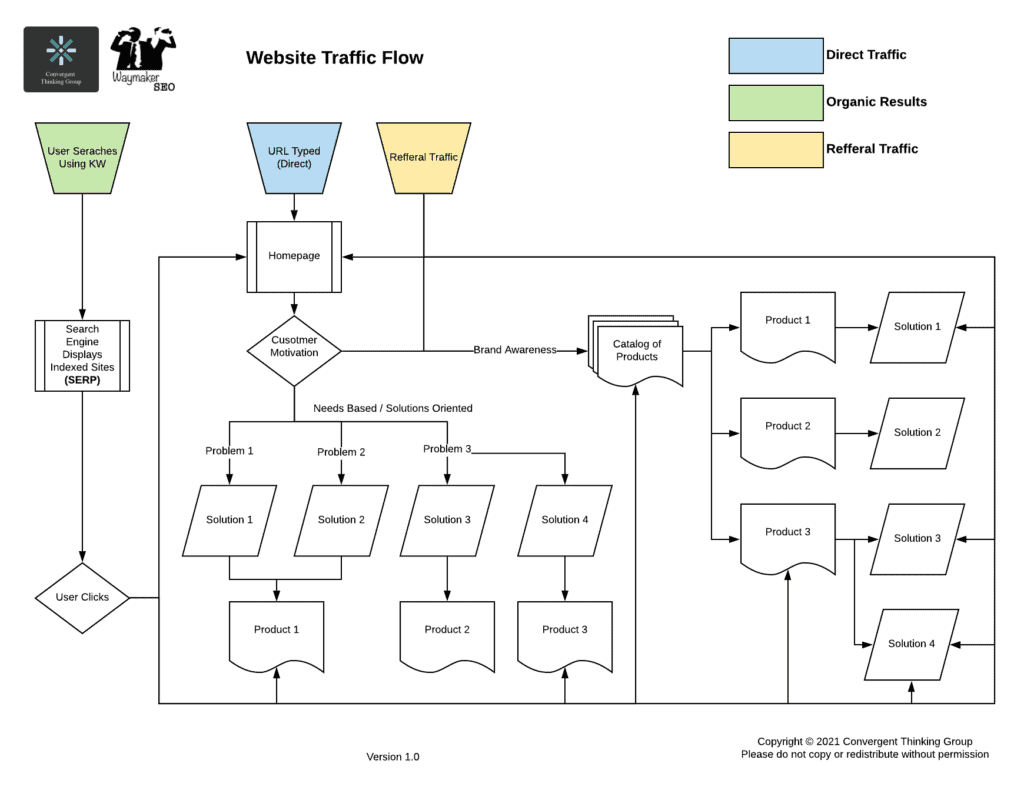SEO Challenges: Website Traffic Flow
One of the challenges with SEO work is that the ranking pages are not necessarily the pages that you want people to jump on. Usually, this happens when you have blog pages or item pages with detailed descriptions that outperform your "main pages."
How does this happen?
I created a visual to explain how websites tend to work and what you can do to make your site capture those visits and turn them into leads.
Website Traffic Flow
Who is coming to your website:
- Direct Traffic - These folks come to your website because they have your URL. Generally, these come from offline marketing materials, links on your email, or some other material with your website address.
- Referral Traffic - This is traffic from another website. If you are getting backlinks from other websites, they could point to your home page or a specific page inside your website. I include Social Media sites profile links here.
- Search Traffic - This is traffic that is coming to your website from Search Engines. These folks could be landing on any number of pages on your website.
What are they looking for, and can you get them there?
- Direct Traffic: This traffic ends to have some familiarity with your brand. Your home page should have pathways to the buying journey based on the visitor's needs. Another way to look at this is your home page is the receiving area for your website. What information do you need to have, and what can you present to the visitor to entice them to move deeper into the site?
- Referral Traffic: This traffic is following a link from another site. How the link is made and to which page may or may not be under your control. If you are linking from social media profiles, then you can point people to specific pages. If these are coming from backlinks, they are most likely pointing to something the other site values. You should check your incoming links and make sure these pages provide some information for these visitors that moves them along a sales process.
- Search Traffic: If you are getting organic visits to your site, check your Search Console information to see which pages people are coming to and ensure you have a Call-to-Action (CTA) in place to turn the visit into a lead. If you have a longer purchase cycle, then be sure to have these pages have signals for visitors to connect with the sale journey you have predefined on your website. I.e., Links to pages that help put these people into a sales process. Help these people get to the process that gets you more business.
How this impacts your SEO results
These different types of traffic can impact your SEO results.
- Direct Traffic: This could be considered an "Offline" proxy for how people know about your website. The number per month is not as important as the trend of visitors. If the number is positive growth, then more people must be aware of your website.
- Referral Traffic: This is tied to backlinks. The better quality and more relevant links will add value to your website. Ideally, the links would also provide traffic that engages positively with your website—the more disparate the experience with the link, the higher chance the link may not be valuable.
- Search Traffic: Google wants people to find what they are looking for and have a good experience with any site they send people to. They are a concierge, and their credibility is on the line every time they suggest which sites you visit.
User Experience Factors
Bounce Rate: If people are coming to your website and navigating away without visiting other pages on your site, it's considered a bounce. This signals that the link or page may not be what people are looking for, i.e., they get to the page and navigate away. Google watches these as signals of user experience.
Pages Visited (Per session): If people are coming to your website and are visiting other pages of your site, this can be considered a good thing, unless users' time on pages is low. Then it looks like people can't find what they are looking for; again, not a great user experience.
Average Time on Site: This is the amount of time a user spends on your website. This is a very conditional factor when you see this in light of the number of pages per session.
In Conclusion
Be mindful of how people are coming to your website and how they are navigating the website. These signals are sent back to Google and used to judge your website. Be sure to make the best experience you can for these visitors and get them to where they need to be.
If you are unaware of any of this information or need help sorting this information out, please schedule a free consultation.
Need Some Help?
Schedule a Free 15 minute consultation to talk through your website and SEO needs.

Senior-level SEO consultant that enjoys helping businesses learn how to SEO their website since 2007. I have over 20 years of experience helping business owners realize their goals through process development, data-driven decision-making, and simplifying complex processes.

